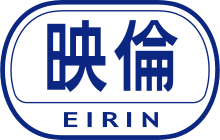Eirin

Eirin (映倫) is the abbreviated name for Eiga Rinri Kanri Iinkai (映画倫理管理委員会), Japan's movie regulator. Eirin was established on the model of the American Motion Picture Producers and Distributors of America's Production Code Administration in June, 1949, on the instructions of the US occupation force. The original name, Eiga Rinri Kitei Kanri Iinkai (Motion Picture Code of Ethics Committee), was condensed after independence, during reorganizations in 1956, to Eirin Kanri Iinkai, but was already colloquially known as Eirin.[1]
Description
As with other countries, Eirin classifies films depending on their suitability for minors, depending on whether they contain sexual or violent material. Eirin's defenders argue that its independence shields film makers from the more draconian alternative, government censorship.
During the opening credits (or in some cases, on the copyright screen immediately following the ending credits) of an Eirin-approved film, the Eirin logo is displayed prominently underneath or beside the movie's title.
Ratings
On May 1, 1998 four rating categories were introduced:[2] R15 and R18 are restricted categories and it is forbidden to admit an underage patron to a film with a restricted rating, rent, sell, exhibit DVDs or motion picture releases to underage patrons with restricted ratings. Such violations are a criminal offense and strictly enforced.
Unrestricted
- G: General Audiences. All ages admitted.
- PG12 (PG-12): Parental Guidance Requested. Some material may be unsuitable for children under 12. Parents are advised to accompany their children during the film.
Restricted
The R15+ and R18+ ratings are age restricted. All cinemas are legally required to check the age of all patrons who wish to view an R15+ or R18+ rated film. Admitting underage patrons to such films is considered a criminal offense and can be punished with fines/imprisonment.
- R15+ (R-15): Restricted to teenagers 15 and over only. Children under the age of 15 are banned from viewing the film.
- R18+ (R-18): Restricted to adults 18 and over only. Children and teenagers (under 18 years of age) are strictly banned from viewing the film.
See also
- Computer Entertainment Rating Organization – The Japanese rating system for video games
- Motion picture rating system
References
- ↑ Martin, Alex, "EIRIN: All movies subject to rating, even cuts, Independent body screens, and censors, flicks", The Japan Times, March 2, 2010, p. 3.
- ↑ "FILM CLASSIFICATION". eirin.jp.